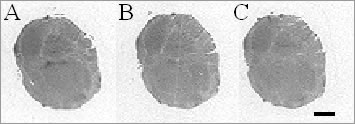Inhibition of 125I-urotensin-II binding to human and rat receptors by a novel non-peptide antagonist, SB657510
Urotensin-II (U-II) is the most potent constrictor yet discovered (Ames et al., 1999; Maguire et al., 2000). Recent reports documenting increased myocardial expression of U-II and its receptor, UT, in patients with heart failure (Douglas et al., 2002) and increased expression of U-II in human atherosclerosis (Maguire et al., 2004) suggest a potential role for U-II antagonists in human cardiovascular disease. We have determined the ability of a novel, non-peptide U-II antagonist, SB657510 (Douglas et al., 2005), to compete for 125IU-II binding in rat brain and human vascular smooth muscle. Male Sprague-Dawley rats (350-450g) were killed by exposure to increasing concentrations of CO2 followed by exsanguination. Human arteries were obtained, with consent, from patients receiving coronary artery bypass grafts. Cryostat-cut coronal sections (30 µm thick) of rat hind brain and sections (20 µm thick) of human mammary and radial artery were preincubated for 30 min in Tris-HCl (20mM, pH 7.4) containing 5mM MgCl2 and 0.2% BSA. For receptor autoradiography, sections were incubated with 0.25nM 125IU-II (human) for 1h, in the absence (total binding) or presence of the U-II antagonist SB657510 (1 µM). Non-specific binding was determined by inclusion of 10 µM human U-II. The experiment was terminated by 10 min wash in ice-cold Tris-HCl (50mM, pH 7.4). Sections were air-dried and apposed to radiation-sensitive film with 125I standards for 5 days. Receptor binding was analysed using the Quantimet System to determine specific binding density in amol mm-2. Data are mean ± s.e.mean, n values are the number of rats or patients from whom tissue was obtained. Figure 1. Receptor autoradiogram showing 125IU-II binding to the abducens nucleus of rat hind brain in the absence (A) and presence (B) of 1 µM SB657510. Non-specific binding defined by 10 µM U-II (C). Scale bar = 2 mm. High levels of specific 125IU-II binding were detected in the abducens nucleus of rat brain (135.8±5.8 amol mm-2, n=3, Figure 1), with lower levels detected in the medial layer of human mammary (13.0±2.3 amol mm-2, n=3) and radial artery (26.7±8.3 amol mm-2, n=3) as previously reported (Maguire et al., 2000). In rat brain SB657510 (1 µM) competed for 73.1±3.6% (n=3) of the 125IU-II binding in the abducens nucleus and for 73.8±13.1% (n=3) and 66.4±8.0% (n=3) of binding in mammary and radial artery respectively. These data suggest that SB657510 has affinity for both rat and human UT receptors and may be useful in identifying the physiological relevance of U-II, if any, in the human cardiovascular system and its potential contribution to disease.
Ames , R.S. et al.,(1999). Nature, 16, 282-286. |


